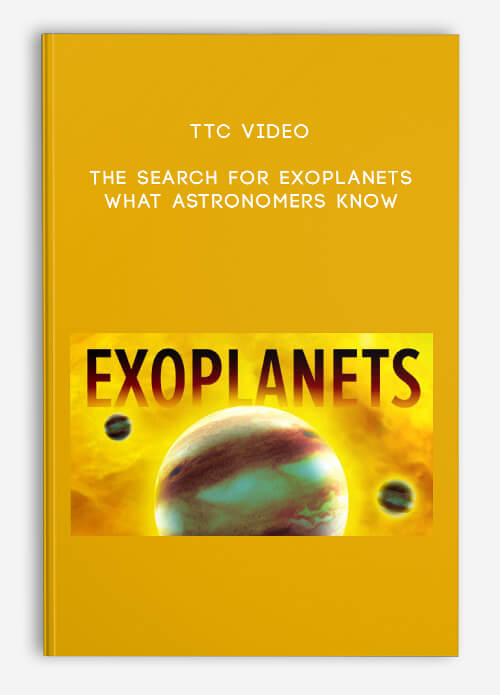
The Search for Exoplanets: What Astronomers Know by TTC Video
Description
Half a century ago, television viewers thrilled to the exploits of the original Star Trek series with its mission “to explore strange new worlds.” Today, astronomers are doing exactly that, analyzing the data from advanced telescopes and discovering strange worlds orbiting other stars in our galaxy.
Most of the countless stars they are monitoring are invisible to the unaided eye, and the thousands of confirmed and candidate planets they’ve detected can’t be imaged directly, except in a few rare cases. Yet researchers are able to use subtle clues obtained in ingenious ways in order to assemble an astonishing picture of planetary systems far different from our own:
Systems containing “hot Jupiters,” giant planets orbiting so close to their host stars that it takes days—not Jupiter’s 12 years—to make one orbit.
Earth-sized planets orbiting even closer—in one case careening around its sun every 8 hours, completing three of its “years” in one of our days.
Planets circling two different suns, recalling the famous scene in Star Wars, where Luke Skywalker watches a double sunset from his home planet.
These results are much more than science fiction brought to life. They are an astronomical revolution, comparable to the Copernican revolution that established our current view of the solar system. As recently as 1990, it seemed possible that the solar system was an unusual or even unique phenomenon in our galaxy. Now we know that planets are everywhere, and we are living during a new golden age of discovery, with the prospect of finding many planets like our own.
The Search for Exoplanets: What Astronomers Know immerses you in this incomparable adventure in 24 beautifully illustrated half-hour lectures conducted by veteran planet hunter Joshua N. Winn, Associate Professor of Physics at the Massachusetts Institute of Technology.
An award-winning teacher, Professor Winn is also a pioneer in the field of exoplanetary science—the study of planets beyond the solar system. He served on the science team of NASA’s Kepler mission, the most productive planet-finding effort to date, and he is taking part in a new space telescope project that will focus on finding rocky planets in the habitable zones of their parent stars, laying the groundwork for the ultimate objective: detecting earthlike planets with the chemical signatures of life. This goal may still be many years away, but meanwhile Dr. Winn and his colleagues are helping to rewrite the book on planet formation and the evolution of planetary systems.
A Scientific Detective Story
Designed for everyone from armchair explorers to serious skywatchers, The Search for Exoplanets follows the numerous twists and turns in the hunt for exoplanets—the false starts, the sudden breakthroughs, and the extraordinary discoveries. Dr. Winn covers all the necessary background, reviewing the simple mathematics of planetary orbits and the scientific principles behind the techniques that eventually found planets at mind-boggling distances from our home base.
Considering that a star is millions to billions of times brighter than even its largest planet, this is a scientific detective story like no other, involving methods such as these:
Astrometry: A star and its planet both orbit their common center of mass, typically a point slightly off-center from the center of the star. In principle, this effect can be observed as a tiny wobble in the star’s position in the sky.
Doppler shift: The slight wobble of a star due to orbiting planets can also be detected as a fluctuating color shift (known as the Doppler shift) in the star’s spectrum, as the star alternately moves toward the observer and then away.
Transit: When a planet crosses in front of a star (known as a transit), it blocks a small percentage of the starlight. Sensitive instruments can measure this minor drop in light level. The greater the dimming, the larger the planet.
Gravitational lensing: A foreground star acts like a lens when it passes in front of a more distant star, bending the light of the background star. If the star in front has a planet in the right position, the light temporarily bends a bit more.
Direct imaging: Most difficult of all is recording an actual image of an exoplanet, which has been compared to spotting a firefly buzzing around a searchlight, with a telescope thousands of miles away. Even so, it has been done!
These techniques not only signal the presence of planetary systems, but also allow astronomers to analyze the data to determine how many planets there are, how large, how far from their parent star, their likely compositions, and the characteristics of their atmospheres. Viewers of The Search for Exoplanets will feel like Dr. Watson in the presence of Sherlock Holmes, as Professor Winn extracts a wealth of information from a spectrum, a light graph, a diffraction pattern, and other subtle clues.
Explore Unknown Worlds
To help you grasp the vastness of the universe, Professor Winn demonstrates a virtual scale-model solar system, centered on Times Square in New York City, that serves as a yardstick for comparisons throughout the course. For example, if the Sun is reduced to the size of an adult human, then at the same scale Earth is the size of a grape, two and a half blocks away, and the closest star with a known planet is 32,000 miles away—a distance 30% greater than the circumference of the entire Earth. Imagine trying to detect a grape at that distance!
The lectures are lavishly illustrated with astronomical photographs, graphics, computer animations, and special effects that help you appreciate the extraordinary variety of planetary systems. And Professor Winn’s personal anecdotes add a human dimension, showing the challenge and excitement of science. Since exoplanetary science is unusually interdisciplinary, you are introduced to a wide range of fundamental ideas, including these:
Astronomy: Among the topics you cover are planetary science, stellar evolution, telescopes, cosmology, and asteroseismology (the science of star “quakes”).
Physics: You investigate orbits, tides, the electromagnetic spectrum, spectroscopy, optics, quantum mechanics, and special and general relativity.
Life sciences: You learn about the quest for life, which combines the search for signals from extraterrestrial intelligence with the hunt for biosignatures of microbial life.
After completing this fascinating course, you will be well equipped to understand one of the most momentous developments of our time. Exoplanets will be making big news for years to come, and at the end of the course Professor Winn describes ambitious projects that are on the drawing board as well as discoveries that he predicts for the near future. Perhaps the only reason exoplanets haven’t attracted more attention is that science fiction long ago prepared us for these wonders. But unlike the adventures on Star Trek, these projects are real. We invite you to join a scientist who is on a mission that can only be compared to the exploits of Columbus, Magellan, and Lewis and Clark.













tristian –
This is Digital Download service, the course is available at Coursecui.com and Email download delivery.